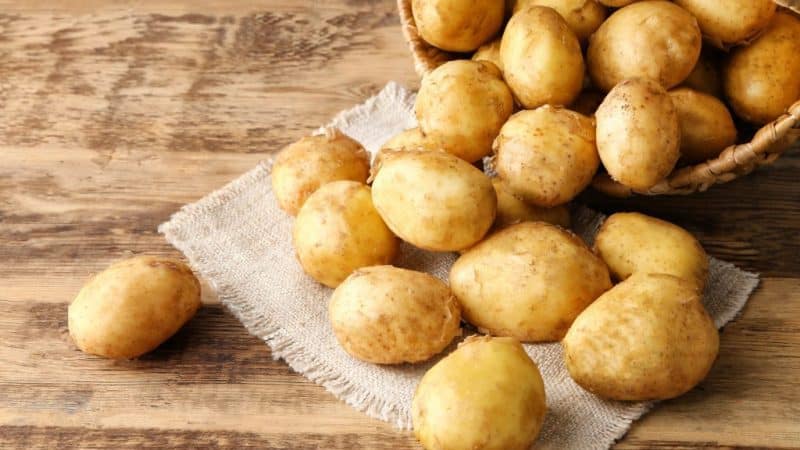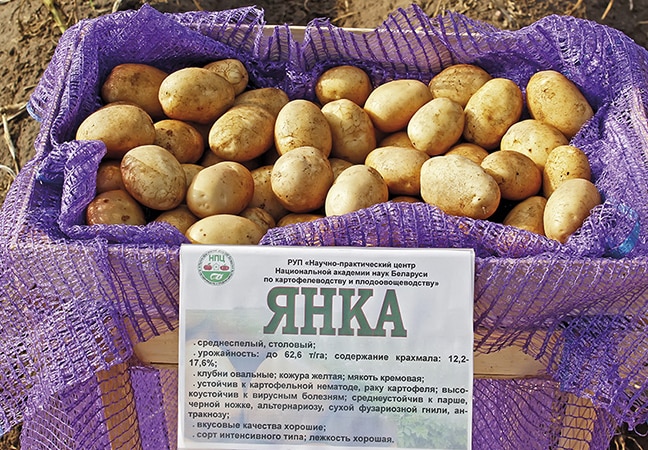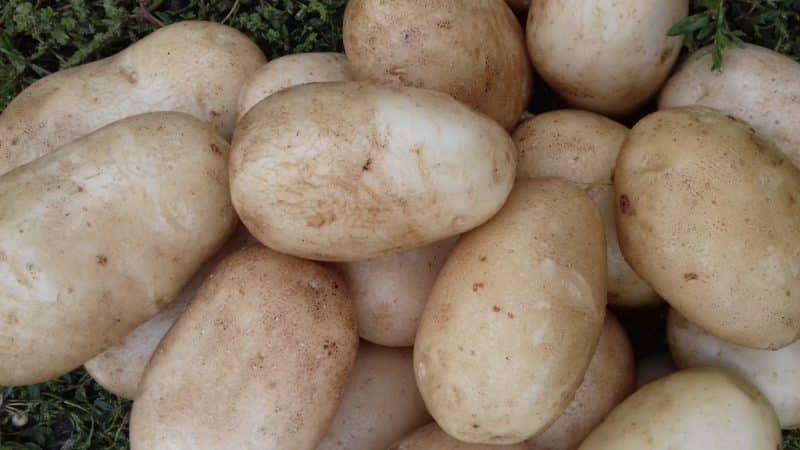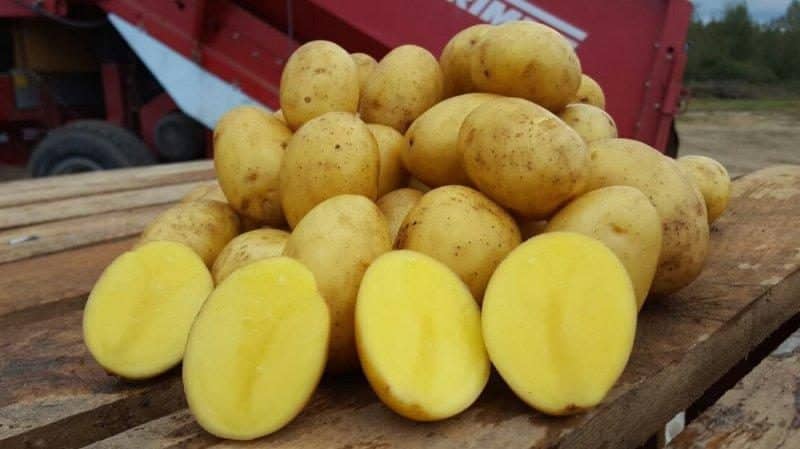High-yielding, mid-season potato variety with a powerful root system “Yanka”
Not long ago, scientists developed a potato variety called Yanka (Yana). Thanks to its excellent taste and unpretentiousness in cultivation, it quickly won the recognition of experienced gardeners. Why is the Yanka variety so good?
Description of the variety
In a short time of existence, the variety managed to gain popularity among farmers due to its yield, resistance to diseases and pests, as well as its presentation.
Origin and development
The variety was bred by Belarusian breeders in the center of potato and fruit and vegetable growing in 2010. Scientists were faced with the task of developing frost-resistant table potatoes, and for two years the variety was subjected to experimental test cultivation. In 2012, it was included in the Russian state register.

Chemical composition, trace elements and vitamins
The Yanka variety, like any potato, contains a large amount of useful substances.
Chemical composition of the variety:
| Name of substance | Content, % |
| Water | 75,3 |
| Starch | 17,5 |
| Sahara | 0,5 |
| Protein | up to 2 |
| Mineral salts | up to 1 |
| Crude protein | 2 |
| Cellulose | 1 |
| Fats | 0,1 |
| Titratable acids | 0,2 |
| Phenols | 0,2 |
| Pectins | 0,6 |
| Energy value 73 Kcal, 305 KJ | |
100 g of product contains the following minerals and vitamins:
| Minerals | Content, mg | Vitamins | Content, mg |
| Potassium, K | 421 | C | 19,7 |
| Phosphorus, P | 57 | B4 | 12,1 |
| Magnesium, Mg | 23 | B3 | 1,054 |
| Calcium, Ca | 12 | B5 | 0,296 |
| Sodium, Na | 6 | B6 | 0,295 |
| Iron, Fe | 0,78 | B1 | 0,08 |
| Zinc, Zn | 0,29 | B2 | 0,032 |
| Manganese, Mn | 0,153 | E | 0,01 |
| Copper, Cu | 0,108 | B9 | 16 mcg |
| K | 1.9 mcg |
Ripening period
Yanka is classified as a mid-season variety - its tubers fully ripen 95-120 days after planting in the soil. The harvest period falls during the warm period of Indian summer - from September 10 to 24.
Productivity
Among the main properties of any potato variety, productivity is important. For the Yankees, her indicators are as follows:
- on average you can collect 195-311 quintals from one hectare;
- one potato bush produces 8-12 potatoes;
- the weight of one tuber is approximately 106 g;
- When digging, small and non-marketable tubers are removed from each bush in the amount of no more than 5% of the total quantity.
Disease resistance

Compared to other potato varieties, Yanka exhibits pronounced resistance to diseases such as potato cancer, wrinkled and striped mosaic, leaf curl virus, as well as to the pest golden cyst nematode. But due to sudden changes in temperature and high humidity, the listed diseases can make themselves felt.
Characteristics of tubers, description of appearance
Potato tubers of the Yanka variety are medium in size and have a regular oval shape. Small and deformed ones are rarely found. The color of the potatoes is uniformly yellow with small brown spots. The pulp is white or cream-colored, dense in consistency, juicy. The eyes are small, of a dull color, and there are few of them. The rhizome of the plant is powerful, widely branched.
During the growing season, the variety forms straight bushes up to 60 cm high with slightly drooping tops. Each bush has up to seven shoots with small, matte light green leaves with a wavy edge.
The inflorescences are pale purple, large. The flowers are pollinated naturally and fall before producing berries.
Regions for cultivation and climate requirements
The originator recommends the North-West and Central regions. However, practice has shown that due to its unpretentiousness, the variety can be grown in almost all regions of Russia.
Advantages and disadvantages of the variety
Yanka, like other potato varieties, has its advantages and disadvantages.
Advantages of the variety:
- High yield.
- Excellent presentation.
- Taste qualities.
- Adaptability to temperate climates and cool summers.
- No tendency for seed material to degenerate.
- Pronounced immunity to potato canker, golden potato cyst nematode, leaf curl virus.
- High percentage of shelf life - 95%.
The variety has very few disadvantages, and they are not so significant:
- Poor tolerance to waterlogged soil.
- Reduced yield at low air temperatures.
Difference from other varieties

Yanka has three main characteristics that distinguish it from others:
- average tuber weight - 90-106 g;
- yield - 195-311 c/ha;
- starch content - 15-17.5%.
Features of planting and growing
Despite the unpretentiousness of the crop, a large harvest of high-quality potatoes is the result of proper planting and care.
Preparing for landing
Before planting, it is necessary to prepare seed material. Both whole tubers and parts of potatoes are suitable for sowing. The tubers are sorted, spoiled and too small potatoes are removed.
If there are few seeds, potatoes cut into pieces are used as seed material. To do this, it is necessary that each part has 3-5 eyes.
Important! When sowing in parts, to prevent damage by putrefactive bacteria, it is necessary to treat the seed with ash and leave to dry for 1-2 days.
In order for tubers planted in the ground to develop faster, they need to be germinated. Germination is carried out approximately a month before the expected planting day. The prepared tubers are placed in one layer in shallow plastic boxes with holes. After this, they are placed one on one in a room near a window.
From time to time the boxes are swapped. If planting will be done in halves, 10 days before sowing, the potatoes are cut into pieces with eyes. On the day of planting, it is recommended to soak the prepared material for one hour in Fitosporin.
Reference. “Fitosporin” is an effective remedy used by gardeners to prevent fungal diseases and rot of potatoes.
Soil requirements
For planting the Yanka variety, soil with an acidity level (pH) of 5.5 to 7 is suitable. In this case, the site must have constant access to sunlight. Before planting, it is advisable to add nutrients to the soil and loosen it.
Attention! Lime or dolomite flour must be added to acidic soil (pH 5.2) before planting to deoxidize it.
The variety grows well and produces yields on loamy and sandy loam soils. On peat soil or black soil, the harvest will be large.
Dates, scheme and rules of planting
You can plant seed when the soil at a depth of 10 cm warms up to 6-8˚C. For the Central and Northwestern regions recommended for planting, this period begins in the second half of May. In more southern territories, planting can begin three weeks earlier.
Planting potatoes is equally effective in trenches, nests (holes), on beds or ridges.
Potatoes are planted at a depth of 10 cm, at a distance of 35 cm between holes, with a distance between rows of 70 cm. To quickly start plant growth and increase productivity, it is recommended to add humus or ash to the hole.
Place two tubers in the holes at a distance of 7 cm and cover them with a 10 cm layer of soil.
Important! The weight of potatoes or their parts for planting should not be less than 30 g, otherwise the harvest will be meager.
Features of cultivation
It is recommended to loosen the soil well before planting. Bad predecessors for the Yankees will be tomatoes, peppers, eggplant and tobacco. These crops have pathogens similar to potatoes that will make themselves felt. The most favorable predecessors: legumes, carrots, cabbage, meadow grasses, corn.
In order for Yanka potatoes to develop properly and please you with a rich harvest, it is necessary to properly water, fertilize, weed and fight diseases and insects.
Watering mode
If there is sufficient rainfall, the variety does not need irrigation. In most cases, potatoes are watered twice. First, when the first shoots appear - after about 14-15 days. The second time - during the formation of buds.
Attention! Irrigation is recommended to be carried out in the evening at the root or along the furrows. Approximate water consumption is 3 liters of water per bush.
Top dressing
Start fertilizing potatoes it is possible already two weeks after the appearance of the first shoots. 1% urea is well suited for these purposes. The ash solution is effective during the period of active growth: 300 g of ash is boiled in 3 liters of water for 25 minutes. After this, the solution is filtered and diluted to a volume of 10 liters.
Weeding and hilling
Hill up the potatoes twice. The first is when the seedlings have reached a height of 15 cm, the second is before flowering. The most favorable time for the procedure is after rain, in the morning or evening. Weeding is recommended to be done as often as possible, preferably after irrigation.
Important! Weeds are an excellent breeding ground for the larvae of click beetles (wireworms), which harm potatoes by eating away the tunnels in the tubers.
Disease and pest control
The variety suffers most from pests and diseases such as the Colorado potato beetle, wireworm and rhizoctonia.
Colorado beetle
When pest It is recommended to use the drugs "Aktara" or "Prestige". The use of these products provides protection for two months, so it is recommended to carry out treatment in the middle of the vegetative cycle.
Wireworm
Click beetle larvae they start in the weeds growing on the site, so it is best to constantly remove the weeds. The pest does not tolerate proximity to mustard.
Rhizoctoniosis
The fungal infection appears as dark spots on the surface of tubers and leaves and can occur at any stage of plant growth. Infection can be prevented by maintaining crop rotation and eliminating infected bushes. The development of the disease should be stopped using Maxim, Agat-25K and Bactofil.
Difficulties in growing
Yanka is unpretentious, but can behave unpredictably when there are sudden changes in air temperature and waterlogging of the soil. The harmful effects of these factors lead to a decrease in immunity to diseases and impair productivity.
Harvest and storage
Proper care of potatoes does not guarantee that the crop will be well preserved until spring.It is advisable to collect it correctly in order to maintain quality material for the next planting season.
How and when to collect

The skin of the tubers, which does not come away from the pulp under mechanical stress, indicates that the crop is ready for harvest. The second sign is the drying of the stems, which occurs approximately 100 days after planting the potatoes. Digging is done using a shovel or fork.
Storage features and keeping quality of the variety
The extracted tubers are laid out to dry on the surface of the ground. At the same time, you should avoid prolonged contact with the sun if the potatoes are intended for food. Two hours is enough. When exposed to the sun, the tuber produces toxic solanine. You cannot eat such potatoes even after heat treatment. But for potatoes for planting, the production of solanine is extremely useful - such tubers are stored longer and are protected from being eaten by pests and rodents.
After air drying for two hours, the tubers are stored indoors and dried for two weeks without access to direct sunlight. It is recommended to gradually reduce the temperature by 0.5-1°C. The entire drying process takes no more than one month.
After this, the potatoes are ready for storage. Damaged and small tubers are removed, and the remaining ones are packaged in nets or covered in wooden boxes.
Important! Even the most careful sorting of potatoes does not prevent spoilage during storage. Therefore, you should sort through the crop several times during the storage period and remove unsuitable tubers.
In the storage room where potatoes are stored, it is necessary to maintain a constant temperature of +2...+4°C.
Suitable humidity for storage is no more than 85%, which helps to avoid the appearance of mold.It is also recommended to fill the bottom of the storage with sand - this helps to avoid excess moisture.
Before storage, a procedure should be carried out to disinfect the premises from fungal and bacterial infections.
Most of the Yankee harvest is perfectly preserved until spring - the keeping quality of the variety reaches 95%, provided that the recommendations for digging and storage are followed.
Reviews about the Yanka variety
People who have already tried to grow the variety on their plots leave mostly positive reviews.
Nikolay, Perm: «I have been planting potatoes for ten years now. During this time I managed to try several varieties. Last year, following the example of my neighbors, I planted Yanka (Yana) potatoes - I liked the characteristics of the variety. But among the neighbors it did not grow very well and the harvest was poor. Since I have experience, I decided to try it. Before planting, half of the seed was cut crosswise into two thirds. This method helps nutrients penetrate the tuber better. The result is an excellent harvest. And the potatoes themselves are delicious, the family loves them.”
Lyudmila, Salavat: “Last year, my husband and I saw a photo of Yanka potatoes, studied the description of the variety and planted them in our garden for the first time. They planted it as expected, but the harvest was not very successful, although everything was done according to the recommendations. It turned out that the culprit was the sunflower, which had previously grown all over the site. Even the kids enjoy eating the potatoes themselves.”
Conclusion
The Yanka variety is not susceptible to many potato diseases and adapts well to any climate and soil. And its excellent taste makes it a welcome guest on any table.